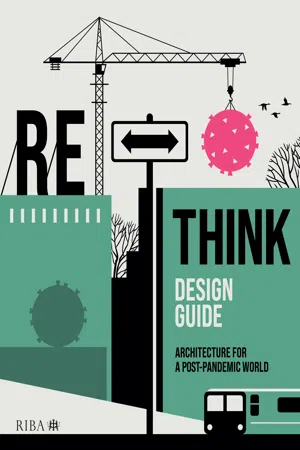
RETHINK Design Guide
Architecture for a post-pandemic world
Nicola Gillen, Pippa Nissen, Julia Park, Adam Scott, Sumita Singha, Helen Taylor, Ian Taylor, Sarah Featherstone, Nicola Gillen, Pippa Nissen, Julia Park, Adam Scott, Sumita Singha, Helen Taylor, Ian Taylor, Sarah Featherstone
- 244 pages
- English
- ePUB (mobile friendly)
- Available on iOS & Android
RETHINK Design Guide
Architecture for a post-pandemic world
Nicola Gillen, Pippa Nissen, Julia Park, Adam Scott, Sumita Singha, Helen Taylor, Ian Taylor, Sarah Featherstone, Nicola Gillen, Pippa Nissen, Julia Park, Adam Scott, Sumita Singha, Helen Taylor, Ian Taylor, Sarah Featherstone
About This Book
The world has changed. How will society emerge post-pandemic? Will we take the opportunity to reset the status quo? And, if so, what possibilities are there for architects to take the initiative in designing this new world? This innovative design guide draws together expert guidance on designing in the immediate aftermath of the pandemic for key architectural sectors: housing, workplace, civic and cultural, hospitality, education, infrastructure and civic placemaking. It provides design inspiration to architects on how they can respond to the challenges and opportunities of a post-pandemic environment and how architects ensure they are at the forefront of the best design in this new world. Looking at each sector in turn, it covers the challenges specific to each, and how delivering these designs might differ from the pre-pandemic world. As well as post-pandemic design, the vital issue of climate change will be threaded through each sector, with many cross-overs between designing for the climate emergency and designing for a world after a pandemic. Both seek to make the world a safer, happier and more resilient place. Written by set of contributing design experts, this book is for all architects, whether sole practitioners or working in a larger practice. As well as inspirational design guidance, it also provides client perspectives – crucial for understanding how clients are planning for the future too.
Frequently asked questions
Information
CHAPTER 1
WORKPLACE

Introduction

- Collaboration increased by 10% through homeworking.
- Colleagues working from home struggle to maintain personal connections, which impacts their learning and connection to company culture.
- Younger generations, especially, are struggling with maintaining a sense of connectedness while working remotely.
- 73% want flexible working to continue.
- The new normal will be a ‘total workplace ecosystem’ – leveraging home, office and third places.
- Core hubs – smaller and higher quality: the core office function would focus on collaboration, learning and development, and client meetings, creating a sense of belonging and brand. Post social distancing, employees may still be expected to spend regular time in these key hubs to ensure informal collaboration and connection to corporate culture. Requirement for individual desking could decrease, but more companies will target central and accessible urban locations for event spaces.
- On-demand event spaces and third spaces: for companies’ increasing remote work or even completely shifting to virtual, there could be a new requirement for on-demand event/collaboration spaces for recurring company and team meetings. Demand for these would be in accessible and memorable locations such as city centres, main transportation hubs including airports, and out-of-town destination hotels. There will be continued demand for third spaces, i.e. people working in cafés, hotel lobbies and in transit.
- Flexible ‘touch down’ space: in larger metropolitan areas with extended employment catchment areas it would make sense to provide additional space on demand, leased on flexible terms. These hubs would be smaller and in less central areas, still surrounded by amenities and public transport. They could welcome employees that want to benefit from corporate workplace infrastructure within reasonable commute distance.
- Local community hubs: to avoid longer commute times and tap into wider employment catchment areas, people could access local community workplace hubs close to where they live. These could be in regional cities, out of town or on local high streets. High-street retail units could be rejuvenated to provide innovative workspaces within walking or cycling distance. These hubs would also satisfy employee appetite for greater engagement within their own communities and increased movement.
Table of contents
- Cover
- Title Page
- Copyright Page
- Contents
- Introduction
- 1 Workplace
- 2 Civic and Cultural
- 3 Housing
- 4 Retail and Hospitality
- 5 Healthcare
- 6 Schools
- 7 Universities and Colleges
- 8 Infrastructure and Placemaking
- Acknowledgements
- Index
- Image credits